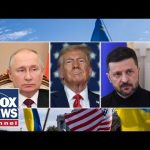The Middle East is poised for significant shifts, and many believe that President Trump is the one to watch as nations in the region look to counter Iranian aggression. During a recent discussion, Secretary of State Marco Rubio emphasized the evolving dynamics within NATO, stating that the organization is only as strong as its weakest member. With a key summit approaching in just six weeks, expectations are high that NATO countries will be stepping up their military contributions. Years after President Trump challenged alliance members to increase their defense budgets, it seems they are finally responding, setting a historic precedent.
NATO’s progress has been promising, with many countries reportedly gearing up to meet or even exceed a defense spending goal of 2% of their GDP. Some may even aim for a whopping 5% in the next decade! This increase in military spending is seen as a critical move to strengthen NATO’s deterrent capabilities, which is essential in preventing wars through collective strength. In a world where peace is often disrupted, a robust NATO is expected to safeguard against potential threats, particularly from Iran, which Secretary Rubio firmly identified as the number one sponsor of terrorism today.
In the context of the ongoing war in Ukraine, the conversation led to the necessity of diplomacy for conflict resolution. There are hints that diplomatic engagements may pave the way for peace, but this would require a significant step: a face-to-face meeting between President Trump and Russian President Vladimir Putin. Secretary Rubio passionately noted that such direct negotiations might be the only viable path toward a breakthrough. He echoed the importance of returning to a focus on building rather than bombing, hoping for a future where conflicts can be resolved through dialogue rather than destruction.
Beyond the war in Ukraine, Iran’s intentions have stirred concerns in the region. The Secretary of State articulated that Iran must abandon its nuclear ambitions and its sponsorship of terrorist organizations like Hezbollah and Hamas. Notably, the U.S. administration has extended an olive branch to Iran, offering a chance for prosperity if it chooses to disengage from aggression. The Iranian regime has long been a source of regional instability, and any nuclear capabilities they might acquire would pose a direct threat to U.S. allies, particularly Israel.
As the conversation shifted to Iran’s nuclear ambitions, Secretary Rubio highlighted the urgency that accompanies the current situation. Iran’s level of uranium enrichment has risen to concerning levels, and the clock is ticking. With a potential for them to transition to weapons-grade enrichment alarmingly fast, the stakes couldn’t be higher. Countries within the Gulf region share these fears, with no appetite for a nuclear-capable Iran. The challenge now lies in convincing the Iranian leadership to abandon their pursuit of nuclear weapons and choose a path that favors peace and stability.
In conclusion, the landscape in the Middle East is changing rapidly. The U.S. has made it a priority to address the Iranian nuclear threat while simultaneously working to strengthen its alliances through NATO. As nations prepare for critical diplomatic dialogues, the hope remains that leaders will choose cooperation over conflict. With one eye on Iran and the other on NATO’s growth, the focus is now on building a future that favors peace, prosperity, and security for all.




